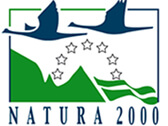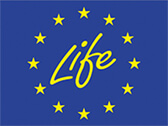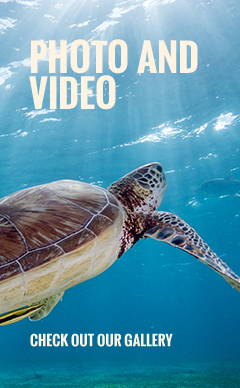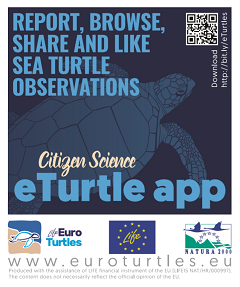In the Mediterranean, conservation programs on sea turtles started at the end of the 1970s and greatly expanded and improved since then.
With more and more scientific knowledge on occurrence, demography, behaviour and threats becoming available, the structure and distribution of the populations, the connections between different countries and their relative importance for turtle conservation are more and more evident. Although the general international perspective of turtle conservation is obvious, nowadays indication are available of the potential value of international cooperation on specific actions. This project aims to improve connections and synergism on key conservation aspects among 6 key EU countries, identified on the basis of the following background.
In the EU, Caretta caretta has major nesting sites in Greece (3500 nests/yr) and Cyprus (900 nests/yr), and limited nesting in Italy (40 ca.), for a total of about 4440 nests/yr, while Chelonia mydas breeds in Cyprus only. Major foraging grounds for loggerheads are in the Adriatic, Ionian, and Aegean, bordered by Italy, Slovenia, Croatia, Malta and Greece and both species have major foraging grounds in the Levantine basin (Cyprus and Greece). These are among the most important areas and countries for the two species at Mediterranean level.
The conservation status of these populations is not clear. Trends of number of nests vary among different nesting sites and in sea turtles they are not easy to interpret because the number of nests is only an indirect index of population abundance, with several ecological and behavioural parameters involved. On the basis of the level of anthropogenic threats, the conservation status should be considered as not good. Nesting sites are threatened by habitat loss caused by development for tourism, intensive beach use, predation by dogs, foxes and other animals favored by human presence. At foraging grounds, sea turtles are incidentally caught and killed in high numbers by fishing gears.
The conservation context of the project is outlined below per each country

Croatia
Main threats:
fishing gear
Main threats to sea turtles in Croatian Adriatic are related to fisheries. The scale of interaction and mortality in fishing gear has significant impact of the entire EU population of loggerhead turtles. Tag recovery data, satellite tracking and genetic analyses showed that Adriatic is inhabited by loggerhead turtles dominantly belonging to Greek nesting population (75%) as the largest EU nesting stock of this species. Therefore, conservation and management of loggerheads in the Adriatic Sea is directly linked to viability of EU sea turtle population.
Incidental capture in fishing gear has been recognized as the major threat with bycatch ranging between 2000–2500 turtle captures in bottom trawls per year and at least 400 – 600 captures in set nets per year in Croatian Adriatic.

Cyprus
Main threats:
fishing gear
Incidental capture in fishing gear is the main threat to sea turtles in Cyprus. Other threats in the project area include light and noise pollution in the nesting beaches, predation on nests, mainly from foxes, as well as increased boat traffic during tourist season in the foraging areas.

Greece
Main threats:
fishing gear
IIn Kyparissia Bay predation affects 50% of deposited clutches. Inundation affects 34% of deposited clutches. This threat is mitigated through relocation of eggs to a safer area. Human beach use can cause serious disturbance to eggs and hatchlings through trampling, vehicular traffic, disorientation from lights at night, beach furniture (umbrellas and deckchairs).
The greatest threat for sea turtles at sea is their entanglement in fishing gears. Bottom trawlers, long-liners and gill-netters put a heavy toll on turtles. Many turtles are captured incidentally in various fishing gears with the result that the gears are damaged and many turtles are found dead or injured. The Sea Turtle Stranding Network, operated by ARCHELON in cooperation with the Coast Guard, reports a dramatic increase of sea turtle dead strandings all over the Greek shoreline. Same increase has been noted in the number of injured turtles admitted at ARCHELON Rescue Centre in Glyfada. The increase of dead and injured turtles is explained by the decreased fish catches which make fishermen more antagonistic to turtles to the extent that many of them attempt to kill or damage intentionally the captured turtles. Of course, many turtles are injured by their entanglement in fishing nets, and by ingesting hooks and lines.
Entrapment in Mesologhi lagoon. This is a special case in Greece where turtles are caught in aquaculture facilities and entangled in left-over fishing gears. The project aims to cooperate with fishermen to release entrapped turtles and clean the lagoon from “ghost gears”.

Italy
Main threats:
fishing gear
General coastal development (human presence, coastal construction, pollution, artificial lighting, beach cleaning, vehicles driving on the beach) might be one of the causes for the probable reduction of nesting activity in Italy. From preliminary surveys in the 1980s and after decades of more attention on these animals, it is evident that Italy does not host major nesting sites like Greece or Cyprus. However, the real level of nesting is still unknown. The most important nesting sites in Italy (Pelagian Archipelago in Sicily and Costa dei Gelsomini in Calabria) were recognized as such by chance and after intensive monitoring efforts. No similar efforts were dedicated to other areas. Therefore, coastal development is probably jeopardizing potential nesting sites even before there are identified or protected, especially in southern Sicily.
The marine areas surrounding Italy are frequented by high numbers of turtles, especially the Adriatic and Ionian, and Italy has one of the largest fishing fleets in the Mediterranean, with several types of fishing gear used. This represents a major threat to sea turtles on a regional scale, with a rough estimation of 24,000 captures per year or more. Two fishing gears are particularly problematic. Trawlers capture high numbers of turtles in the shallow waters of the Adriatic and the Tunisian shelf while longliners capture high numbers of turtles in the Ionian and the Strait of Sicily.

Slovenia
Main threats:
fishing gear
The threats to sea turtles in Slovenian territorial waters are the same as those for the Northern Adriatic Sea in general. These include incidental capture in fishing gear, particularly with bottom set-nets (gillnets and trammel nets), and, in the smaller extension, bottom trawls. Other sources of mortality include boat strikes and ingestion of plastics. A survey carried out in the north-eastern Adriatic conservatively estimated loggerhead bycatch of Slovenian gillnet fleet at 70 captures/year, with Bycatch Per Unit Effort (BPUE) of 2.81 turtles/year/vessel and direct mortality of 74.7%. If this BPUE is extrapolated to multifunctional vessels, a potential gillnet bycatch may be as high as about 270 captures/year. Though most of multifunctional vessels use gillnets, their fishing effort is probably lower than of the exclusive gillnetters, most likely resulting in lower BPUE and lower bycatch rates. Bycatch in bottom trawls is certainly much lower, due to the small fleet size and the absence of loggerheads from Slovenian waters during the winter as the peak season of trawl bycatch in the Adriatic.



